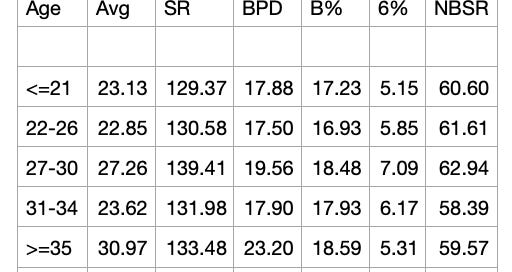The post-Covid sporting world isn’t the same as before March 2020, and we’ve seen across various sports something of a changing of the guard in terms of veteran players move aside for the new talent who have developed into top-level players.
In tennis, for example, we’ve seen the dwindling of the traditional ‘elite four’, with Federer, Nadal, Djokovic and Murray moving aside at various speeds with the likes of Carlos Alcaraz and Daniil Medvedev replacing them as the potential superstars of the next decade. In football, it’s the same - the big money is now being spent on young players with high potential.
But in cricket, it’s not so much the case. At the IPL mega-auction in February 2022, and in the retention process for the several months prior to that auction, there’s still a dynamic where older players, some who are evidently in decline, are still commanding big retention or sale prices. It’s not an exclusively IPL-related dynamic either - for me, it’s one of the biggest inefficiencies in the cricket recruitment market in general.
Just this week, we saw that Suresh Raina announce that he was no longer available for the IPL, and would be available for other leagues. But why would a team in an overseas T20 league want an overseas player who went unsold as a domestic player in the last IPL auction? The ironic thing is I think that he would have a strong chance of getting deals.
Why do teams take these approaches? Emotion can be an influence, particularly if the player has been at a franchise for a long period of time and has been a key part of the team, and teams may often prefer to be what they could perceive to be risk-averse - unwilling to risk losing a player around 30 years of age to a rival - even though that strategy may actually be a riskier strategy than releasing that player, given the potential for decline, particularly for bowlers, as a player ages into their 30s. There is also often a tendency that I’ve noticed in this industry where decision-makers tend to remember the best historical performances from a player, as opposed to trying to ascertain the player’s actual ability to replicate these performances in the future - cognitive bias.
Other factors such as branding/marketing value are often also mentioned as a rationale here. This is an interesting discussion given that an IPL franchise cannot reinvest the money from off-field activity into their actual playing squad (because there is a budget cap which basically everyone maxes out), so any off-field value has to be spent somewhere else, or go into the owner’s pocket. Unless you take an extreme long-term view, it’s very difficult for any ‘marketing value’ to have an impact on a franchise’s chances of success - so in my view, it’s simply a poor excuse to justify an overpriced piece of recruitment.
Rational decision-making rarely factors in any emotion whatsoever. In an efficient market, teams don’t just need to consider the likely current level of a player, but also their expected level in the future, and whether this represents value for money. A conveyor-belt like approach where players are continually recruited at a fairly young age and then continually either released, or retained at a lower cost when players reach peak age, looks like being a very viable strategy, but I’m yet to see much evidence of teams taking such an approach.
What I’m going to do now, to illustrate these points of view, is to take a look at a few pieces of data from this year’s IPL 2022.
First of all, here’s a look at the basic age/performance breakdown in IPL 2022 for various age brackets, with ages calculated at a 1/4/22 cut-off point:-
Keep reading with a 7-day free trial
Subscribe to Dan’s Newsletter to keep reading this post and get 7 days of free access to the full post archives.


